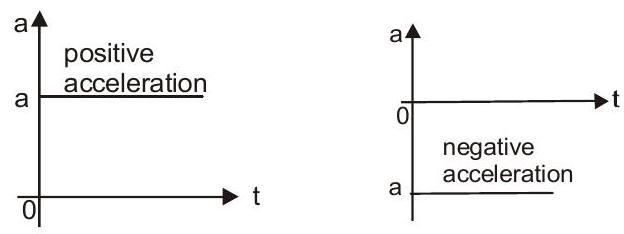Rectilinear Motion
Average Velocity (in an interval) :
$$ v_{av} = \overline{v} = \langle v \rangle = \frac{ \text{Total displacement}}{\text{ Total time taken}} = \frac{\vec{\mathrm{x_f}} - \vec{\mathrm{x_i}}}{\Delta t} $$
Average Velocity For n Velocities:
$$\frac{1}{v_{av}}= \frac{1}{v_1} +\frac{1}{v_2} +…+ \frac{1}{v_n}$$
Average Speed (in an interval):
$$\text{Average Speed} =\frac{ \text{Total distance travelled} }{ \text{ Total time taken }}$$
Instantaneous Velocity (at an instant) :
$$\vec{\mathrm{v}}_{\mathrm{inst}}=\lim _{\Delta \mathrm{t} \rightarrow 0}\left(\frac{\Delta \vec{\mathrm{x}}}{\Delta \mathrm{t}}\right)$$
Average Acceleration (in an interval):
$$v_{av} = \frac{\Delta \vec{v}}{\Delta t} = \frac{\vec{v_f} - \vec{v_i}}{\Delta t}$$
Instantaneous Acceleration (at an instant):
$$\vec{a}=\frac{d \vec{v}}{d t}=\lim _{\Delta t \rightarrow 0}\left(\frac{\vec{\Delta v}}{\Delta t}\right)$$
Graphs in Uniformly Accelerated Motion along a straight line $(a \neq 0)$:
- $x$ is a quadratic polynomial in terms of $t$. Hence $x-t$ graph is a parabola.
x-t graph

v-t graph
- $v$ is a linear polynomial in terms of $t$. Hence $v-t$ graph is a straight line of slope a.

a-t graph
- a-t graph is a horizontal line because a is constant.

Maxima & Minima
-
At maximum: $$\frac{dy}{dx} = 0,\quad \frac{d}{dx}\left(\frac{dy}{dx}\right)<0 $$
-
At minima: $$\frac{dy}{dx} = 0,\quad \frac{d}{dx}\left(\frac{dy}{dx}\right)>0 $$
Equations of Motion (for constant acceleration):
,
(a) $ v=u+a t$
(b) $s=u t+\frac{1}{2}a t^{2} \quad s=v t-\frac{1}{2}a t^{2} \quad x_{f}=x_{i}+u t+\frac{1}{2} a t^{2}$
(c) $ v^{2}=u^{2}+2 a s$
(d) $\mathrm{s}=\frac{(\mathrm{u}+\mathrm{v})}{2} \mathrm{t}$
(e) $s_{n}=u+\frac{a}{2}(2 n-1)$
For freely falling bodies: $u = 0$
(taking upward direction as positive)
(a) $\mathrm{v}=-\mathrm{gt}$
(b) $\mathrm{s}=\frac{1}{2} \mathrm{gt}^{2} \hspace{10mm}\mathrm{s}=\mathrm{vt}+\frac{1}{2} \mathrm{gt}^{2} \hspace{10mm}h_{f}=h_{i}-\frac{1}{2} g t^{2}$
(c) $v^{2}=2 g s$
(d) $\quad s_{n}=-\frac{g}{2}(2 n-1)$





